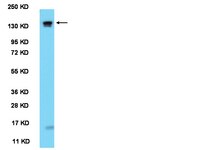KPNB1 mediates PER/CRY nuclear translocation and circadian clock function.
Lee, Y; Jang, AR; Francey, LJ; Sehgal, A; Hogenesch, JB
eLife
4
2015
Show Abstract
Regulated nuclear translocation of the PER/CRY repressor complex is critical for negative feedback regulation of the circadian clock of mammals. However, the precise molecular mechanism is not fully understood. Here, we report that KPNB1, an importin β component of the ncRNA repressor of nuclear factor of activated T cells (NRON) ribonucleoprotein complex, mediates nuclear translocation and repressor function of the PER/CRY complex. RNAi depletion of KPNB1 traps the PER/CRY complex in the cytoplasm by blocking nuclear entry of PER proteins in human cells. KPNB1 interacts mainly with PER proteins and directs PER/CRY nuclear transport in a circadian fashion. Interestingly, KPNB1 regulates the PER/CRY nuclear entry and repressor function, independently of importin α, its classical partner. Moreover, inducible inhibition of the conserved Drosophila importin β in lateral neurons abolishes behavioral rhythms in flies. Collectively, these data show that KPNB1 is required for timely nuclear import of PER/CRY in the negative feedback regulation of the circadian clock. | | 26319354
 |
Responses of brain and behavior to changing day-length in the diurnal grass rat (Arvicanthis niloticus).
Leach, G; Ramanathan, C; Langel, J; Yan, L
Neuroscience
234
31-9
2013
Show Abstract
Seasonal affective disorder (SAD) is a major depressive disorder that recurs in the fall and winter when day-length gets short. It is well accepted that day-length is encoded by the principal circadian clock located in the suprachiasmatic nucleus (SCN), but very little is known about day-length encoding in diurnal mammals. The present study utilized the grass rat, Arvicanthis niloticus, to investigate how the circadian system responds to photoperiodic changes in a diurnal mammal that shows day-length-dependent mood changes. The animals were initially housed in equatorial day-length (12h, EP) followed by either long (16h, LP) or short (8h, SP) photoperiods. The LP animals showed an expansion of the peak phase of the PER1 and PER2 rhythm in the SCN as well as an extended behavioral active phase. In contrast, the SP animals did not show any compression of their active phase nor a change in the peak duration of PER1 or PER2 expression, compared to those in EP. The results suggest that the circadian system in the diurnal grass rats is less responsive when day-length gets short compared to when it gets longer. The depression-like behaviors were assessed using sweet solution preference (SSP) and forced swimming test (FST). Animals in the SP group showed decreased SSP and increased immobility time in FST as compared to the EP group, suggesting a depressive phenotype. The present study serves as the first step toward exploring the role that the circadian system plays in SAD using a diurnal rodent model. | Immunohistochemistry | 23313227
 |
Antibodies for assessing circadian clock proteins in the rodent suprachiasmatic nucleus.
LeSauter, J; Lambert, CM; Robotham, MR; Model, Z; Silver, R; Weaver, DR
PloS one
7
e35938
2012
Show Abstract
Research on the mechanisms underlying circadian rhythmicity and the response of brain and body clocks to environmental and physiological challenges requires assessing levels of circadian clock proteins. Too often, however, it is difficult to acquire antibodies that specifically and reliably label these proteins. Many of these antibodies also lack appropriate validation. The goal of this project was to generate and characterize antibodies against several circadian clock proteins. We examined mice and hamsters at peak and trough times of clock protein expression in the suprachiasmatic nucleus (SCN). In addition, we confirmed specificity by testing the antibodies on mice with targeted disruption of the relevant genes. Our results identify antibodies against PER1, PER2, BMAL1 and CLOCK that are useful for assessing circadian clock proteins in the SCN by immunocytochemistry. | | 22558277
 |
Nighttime dim light exposure alters the responses of the circadian system.
D Shuboni,L Yan
Neuroscience
170
2010
Show Abstract
The daily light dark cycle is the most salient entraining factor for the circadian system. However, in modern society, darkness at night is vanishing as light pollution steadily increases. The impact of brighter nights on wild life ecology and human physiology is just now being recognized. In the present study, we tested the possible detrimental effects of dim light exposure on the regulation of circadian rhythms, using CD1 mice housed in light/dim light (LdimL, 300 lux:20 lux) or light/dark (LD, 300 lux:1 lux) conditions. We first examined the expression of clock genes in the suprachiasmatic nucleus (SCN), the locus of the principal brain clock, in the animals of the LD and LdimL groups. Under the entrained condition, there was no difference in PER1 peak expression between the two groups, but at the trough of the PER 1 rhythm, there was an increase in PER1 in the LdimL group, indicating a decrease in the amplitude of the PER1 rhythm. After a brief light exposure (30 min, 300 lux) at night, the light-induced expression of mPer1 and mPer2 genes was attenuated in the SCN of LdimL group. Next, we examined the behavioral rhythms by monitoring wheel-running activity to determine whether the altered responses in the SCN of LdimL group have behavioral consequence. Compared to the LD controls, the LdimL group showed increased daytime activity. After being released into constant darkness, the LdimL group displayed shorter free-running periods. Furthermore, following the light exposure, the phase shifting responses were smaller in the LdimL group. The results indicate that nighttime dim light exposure can cause functional changes of the circadian system, and suggest that altered circadian function could be one of the mechanisms underlying the adverse effects of light pollution on wild life ecology and human physiology. | | 20705120
 |












